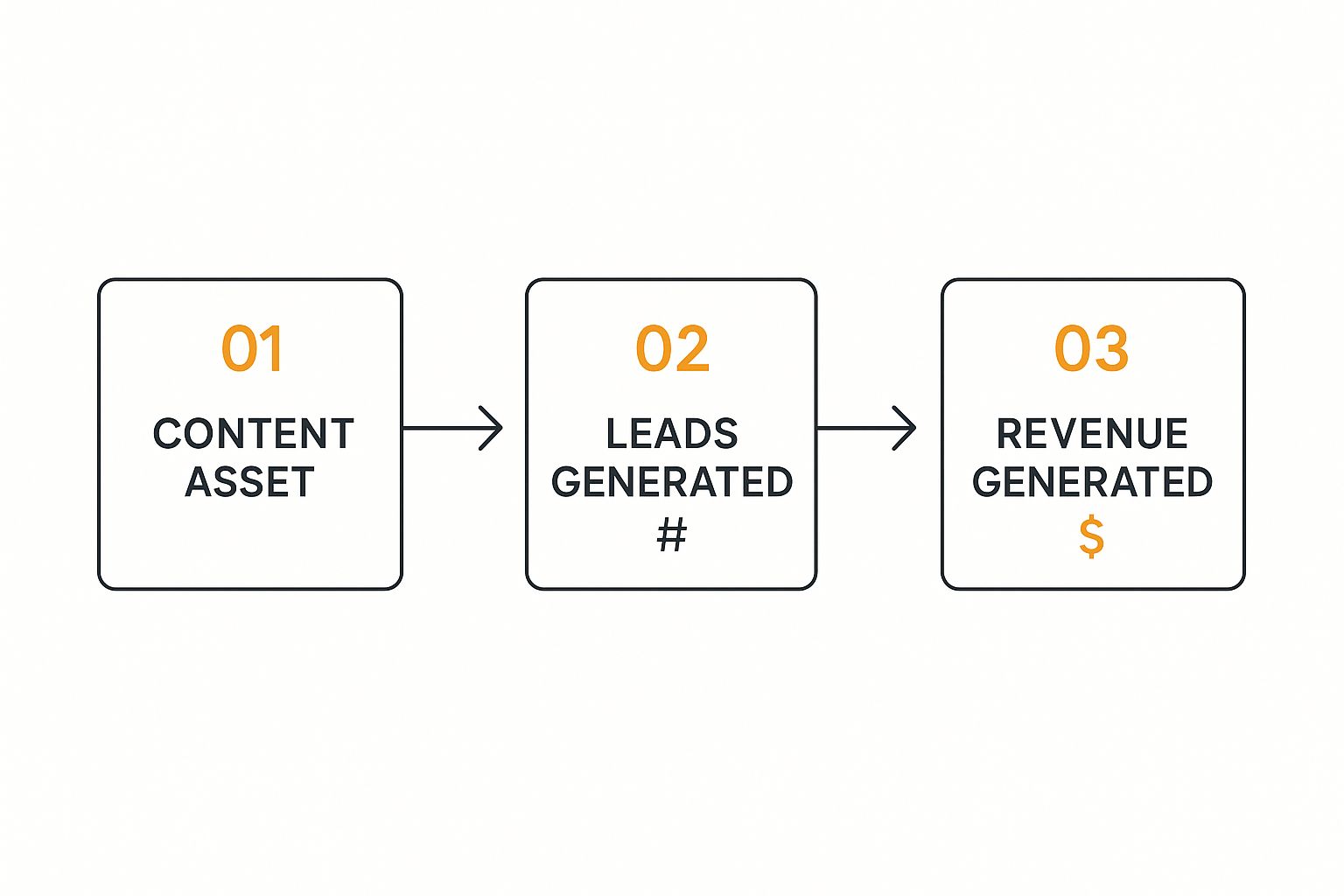Figuring out your content marketing ROI is all about connecting what you spend on content to the money it brings in. The classic formula is a good starting point: (Return - Investment) / Investment x 100%. This simple math turns fuzzy metrics into a hard percentage that shows exactly how your content is impacting the bottom line.
Stop Guessing and Start Proving Your Content's Value

Let’s be honest, proving your content’s worth can feel like a constant uphill battle. You know the blog posts, videos, and guides are working, but translating that gut feeling into a number that your boss or client understands? That’s a whole different ball game.
We need to get past just looking at traffic and clicks. True ROI means tying every piece of content you create directly back to real business goals. Before we get into the nitty-gritty of content calculations, it's worth brushing up on the fundamental definition of Return on Investment (ROI) to make sure we're all on the same page.
The main challenge isn't the formula itself. It’s the messy, detailed work of tracking every single cost and correctly attributing every dollar of revenue back to a specific blog post or video.
This part is absolutely crucial, yet it's where so many businesses stumble. It's actually surprising to learn that only 54% of companies around the world even bother to measure their content marketing ROI. Think about that. The ones who do it right are almost always the ones who get bigger budgets, because leadership can clearly see what worked last time when deciding where to put money next.
Ultimately, a solid measurement plan is what separates a good content strategy from a great one. When you have a clear framework, you can stop guessing and start showing real financial impact. A well-defined approach, like the one we map out in our complete content marketing strategy guide, ensures every piece of content has a clear purpose and a measurable outcome. You can find that detailed breakdown right here: https://redactai.io/blog/content-marketing-strategy-guide.
Get Your Data House in Order for Accurate ROI Tracking

Before you even dream of plugging numbers into a fancy ROI formula, you need data you can actually trust. Let's be honest, this is the unglamorous part of the job, but it's the bedrock for everything else. Get this wrong, and your entire calculation is built on a house of cards.
The whole point is to draw a clean, clear line from someone’s first click on your blog post all the way to them becoming a paying customer. This goes way beyond just installing Google Analytics. It's about ensuring your tools are properly synced and capturing the right information so you can measure your content's real impact.
Connect Your Critical Data Sources
First things first: your website analytics and your Customer Relationship Management (CRM) system need to be talking to each other. This is non-negotiable. This connection is what lets you see that a specific blog post didn't just generate a lead, but that the lead eventually closed a $10,000 deal.
Next up, you have to get serious about UTM parameters. Think of these as little breadcrumbs you add to your URLs. They tell your analytics exactly where every single visitor came from. One messy UTM link can throw off an entire quarter's worth of data, no joke.
I once saw a team accidentally use the same UTM source for both their paid LinkedIn ads and their organic posts. They spent three months thinking their organic social was a goldmine, when in reality, their ad spend was doing all the heavy lifting. Clean data prevented a very bad budget decision.
Here’s a quick-and-dirty checklist to make sure your tracking is solid:
- Define conversion goals: Go into Google Analytics right now and define what a "win" looks like. Is it a demo request? A newsletter signup? A contact form submission? Make it official.
- Establish a strict UTM structure: Create a naming convention for your campaigns (e.g.,
utm_source=linkedin,utm_medium=social,utm_campaign=q3-ebook) and treat it like gospel. No exceptions. - Automate lead source tagging in your CRM: Set up your CRM to automatically tag every new lead with its original source, pulling that info directly from your UTM data.
Nailing these technical details is what separates fuzzy metrics from a real, bankable ROI. And if you're trying to wrangle data from multiple channels, using some of the best social media analytics tools can really help pull everything into one place.
Calculate Your True Content Investment
To get to ROI, you first need to nail down the "I"—your total investment. And if you want a real, honest-to-goodness number, you've got to look past the obvious expenses.
It's easy to just add up the freelancer invoices and your monthly subscription to RedactAI. Those are your direct costs, plain and simple. But the real, often-overlooked costs are the ones that don't show up on an invoice.
Tallying Up Every Expense
The single biggest cost most teams forget? Their own time.
Every hour your team spends brainstorming, outlining, editing, or even just sitting in a kickoff meeting has a dollar value. If you skip this, you’re basically lying to yourself with a falsely inflated ROI. It feels good, but it's not the truth.
So, how do you actually put a price on your team's time? It's pretty straightforward. Figure out an employee's hourly rate (their annual salary divided by 2,080 working hours). Then, you just have to track the hours they put into a specific piece of content.
Let's say a marketing manager who makes $80,000 a year (that's roughly $38.50/hour) spends 10 hours guiding a new whitepaper from concept to launch. That's $385 that absolutely must be added to the investment total. That time isn't free just because they're on salary.
To get a number you can stand behind, you need to add everything together. A complete investment picture includes both the easy-to-see costs and the time you just calculated.
Here’s what your final list should cover:
- Content Creation: What did you pay your writers, designers, and video producers?
- Software & Tools: The cost of your scheduling tools, analytics platforms, and any other tech involved.
- Promotional Spend: Any cash you put behind paid ads, social media boosts, or influencer campaigns.
- Internal Team Time: The big one—the calculated hourly cost for every single person on your team who had a hand in the project.
Once you add all that up, you have your true investment. This isn't just about getting the math right; it gives you a crystal-clear view of where your team's energy and your budget are really going.
Alright, let's connect your content to what really matters: the bottom line. This is where we stop talking about page views and start talking about actual dollars.
It's time to draw a straight line from your content to your revenue. For an e-commerce store, that might be a direct purchase from a blog post reviewing a product. If you're in B2B, it’s about tying that whitepaper download to the demo request it generated a month later.
This is the goal—a clear path from content creation to lead generation and, finally, to revenue.

Think of it as building a case for every piece of content you create, with the final piece of evidence being its impact on sales.
Look Beyond the Final Click
Here’s the biggest trap most marketers fall into: last-click attribution. This model gives 100% of the credit to whatever a person clicked right before they converted. It’s simple, but it's also incredibly shortsighted.
Think about it. A potential customer reads three of your blog posts over a few weeks, gets familiar with your brand, and then sees a retargeting ad on social media. They click the ad and buy. Last-click attribution gives all the glory to the ad, completely ignoring the hard work your blog posts did to warm them up.
To get the real story, you have to use multi-touch attribution. These models spread the credit across the different pieces of content that influenced a buyer, giving you a much more honest picture of what’s actually working.
To track sales content's revenue impact accurately, you need a model that reflects the messy, non-linear path people take before they buy.
Choosing the Right Attribution Model
Not all multi-touch models are the same. Each one tells a slightly different story about the customer journey, so you'll want to pick the one that best fits your business and sales cycle.
| Attribution Model | How It Works | Best For |
|---|---|---|
| Linear | Spreads credit evenly across every single touchpoint. | Longer sales cycles where every interaction is considered equally important for nurturing. |
| Time-Decay | Gives more credit to touchpoints closer to the conversion. | Shorter, consideration-heavy sales cycles where the final interactions are most persuasive. |
| U-Shaped | Gives 40% credit to the first touch, 40% to the last, and the remaining 20% is split among the middle touches. | Businesses that value both initial awareness (first touch) and the final decision-driver (last touch). |
| W-Shaped | Assigns 30% credit to the first touch, 30% to the lead creation touch, 30% to the final touch, and 10% to the rest. | B2B models with a distinct MQL or lead creation stage that is a critical milestone in the funnel. |
Ultimately, the goal is to acknowledge that content often plays the long game. The right model helps you prove it.
Dig Into Your CRM for Proof
Your CRM is a treasure chest of attribution data. This is where you can find out that a new customer actually first found you through a blog post six months before they finally reached out for a demo.
This is how you prove the ROI of that top-of-funnel content that isn't designed to sell immediately but is crucial for building trust.
And the effort is worth it. For B2B companies, a solid baseline for content marketing ROI is around 3:1—that’s $3 in revenue for every $1 you spend. When your content is well-optimized and tracked correctly, that number can go way, way up.
If you want to dive deeper into this, we have a complete guide on how to measure content performance: https://redactai.io/blog/how-to-measure-content-performance.
Let's See the ROI Formula in Action: A Real-World Example

Theory is one thing, but seeing the numbers play out is where it all clicks. Let's walk through a common scenario to make this ROI calculation less abstract and more of a practical tool you can use tomorrow.
Picture this: your team just launched a comprehensive guide on a hot industry topic. Now, let's connect the dots from cost to revenue.
Tallying Up the Investment
First things first, we need to get a handle on what you actually spent. Remember, this goes beyond just paying a writer. You have to account for every dollar that went into creating the content and getting it in front of the right eyeballs.
Here’s a realistic breakdown:
- Content Creation: You hired a freelance specialist to write the guide, which cost $1,000.
- Design & Graphics: To make it look professional, you paid a designer $500 for custom images and a polished layout.
- Promotional Ads: You ran a LinkedIn ad campaign to drive downloads, spending $500.
So, your total upfront cost—the Investment—comes out to $2,000.
Calculating the Payoff
Now for the exciting part—figuring out what you got back. Your campaign tracking shows the guide brought in 80 solid, qualified leads. Over the next quarter, the sales team worked their magic and closed 10 of those leads, turning them into paying customers.
Let's say each new customer is worth an average of $1,200 in their first year.
The math here is straightforward: 10 customers x $1,200 per customer = $12,000 in new revenue.
Time to Plug it In:
(Return - Investment) / Investment x 100
($12,000 - $2,000) / $2,000 x 100 = 500%
A 500% ROI is a home run. It means for every single dollar you invested in that guide, you got five dollars back. This is the kind of hard number that gets attention and proves your content is more than just a "nice-to-have."
Nailing this calculation is huge. As the content marketing industry barrels toward a projected $107 billion by 2026, the pressure to prove value is only going up. Yet, a surprising 47% of marketers say they still can't accurately track revenue attribution. If you want to dig deeper, you can explore more marketing stats to see just how much a systematic approach like this can make you stand out.
Got Questions About Content ROI? Let's Talk.
We've walked through the formulas and frameworks, but let's be real—the messy, real-world situations rarely fit perfectly into a spreadsheet. So, let's tackle some of the most common questions I hear when people start getting serious about measuring their content marketing ROI.
How Long Does This Actually Take?
This is the big one, isn't it? The classic "it depends" answer is frustrating, but it's the truth. The timeline for seeing a return is completely tied to your strategy.
Content built for SEO is a long game. Think of it like planting a tree, not flipping a switch. You're building an asset that grows in value over time, so you might not see a meaningful return for 6-12 months. But the magic is in the compounding effect. That blog post that feels like a dud for the first six months could easily become your top lead generator by year two.
On the flip side, if you're promoting content with paid ads or blasting it to your warm email list, you could see a return within days or weeks. It all comes down to aligning your expectations with the channels you're using.
What If My Content Doesn't Directly Make a Sale?
First off, that's totally normal. In fact, most top-of-funnel content shouldn't be going for the hard sell. Its job is to build awareness and earn trust, not close a deal on the spot.
For this kind of content, you have to get comfortable with proxy metrics. These are the breadcrumbs that tell you you're on the right path. Instead of looking for direct sales, track things like:
- Newsletter Sign-ups: How many people read that article and decided they wanted to hear more from you?
- Branded Search Growth: Are more people Googling your company name after you launched a big campaign?
- Resource Downloads: Did your free checklist or template get downloaded a bunch?
From there, you can start to assign a value to those actions. For instance, if you know from past data that each new email subscriber is worth roughly $5 to your business over their lifetime, you can begin to calculate a directional ROI, even without an immediate purchase.
The goal of top-of-funnel content isn't always to convert—it's to start a conversation. You measure its success by looking at how well it nudges someone to the next step, no matter how small that step might be.
How on Earth Do I Measure ROI for a Podcast or Video Series?
Ah, the brand-building assets. Things like podcasts and video shows are notoriously tough to link directly to revenue. Chasing direct attribution here is often a fool's errand. Instead, shift your focus to measuring influence and engagement.
It requires a bit of creativity. For example, you could create a unique, easy-to-remember URL (like yoursite.com/specialoffer) that you only mention on the podcast. Any traffic to that specific page is a direct result of your show.
You can also track the conversation around your brand—are social media mentions climbing? Another simple tactic is to add a "How did you hear about us?" field to your checkout or sign-up forms. It's about piecing together the evidence of influence, not finding a single smoking gun.
Ready to create LinkedIn content that actually drives results? RedactAI uses your unique voice to generate engaging posts in minutes, helping you build a powerful personal brand that attracts leads. Start for free and see the difference.























































































